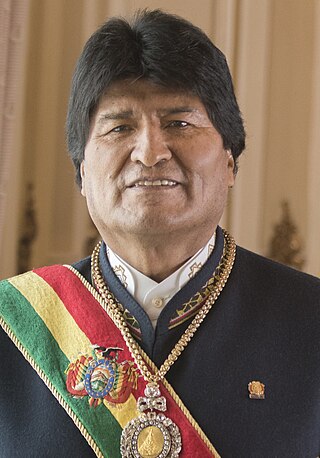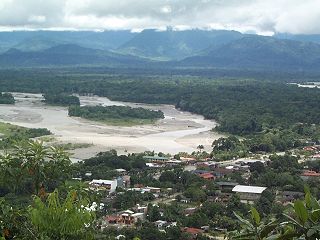
Coca eradication is a strategy promoted by the United States government starting in 1961 as part of its "War on Drugs" to eliminate the cultivation of coca, a plant whose leaves are not only traditionally used by indigenous cultures but also, in modern society, in the manufacture of cocaine. The strategy was adopted in place of running educational campaigns against drug usage. The prohibitionist strategy is being pursued in the coca-growing regions of Colombia, Peru, and formerly Bolivia, where it is highly controversial because of its environmental, health and socioeconomic impact. Furthermore, indigenous cultures living in the Altiplano, such as the Aymaras, use the coca leaf in many of their cultural traditions, notably for its medicinal qualities in alleviating the feeling of hunger, fatigue and headaches symptomatic of altitude sicknesses. The growers of coca are named Cocaleros and part of the coca production for traditional use is legal in Peru, Bolivia and Chile.

Juan Evo Morales Ayma is a Bolivian politician, trade union organizer, and former cocalero activist who served as the 65th president of Bolivia from 2006 to 2019. Widely regarded as the country's first president to come from its indigenous population, his administration focused on the implementation of left-wing policies, improving the legal rights and socioeconomic conditions of Bolivia's previously-marginalized indigenous population and combating the political influence of the United States and resource-extracting multinational corporations. Ideologically a socialist, he has led the Movement for Socialism (MAS) party since 1998.

Chapare (Spanish: [t͡ʃaˈpa.ɾe], also called The Chapare, is a rural province in the northern region of Cochabamba Department in central Bolivia. The majority of the territory consists of valley rainforests that surround the area's main waterway, the Chapare River, which is also a tributary of the Amazon River. The provincial capital is Sacaba, 11 km east of Cochabamba. Its principal town is Villa Tunari, a popular tourist destination.
Alison Louise Spedding is a British anthropologist and fantasy author.

Cocaleros are the coca leaf growers of Peru and Bolivia. In response to U.S.-funded attempts to eradicate and fumigate coca crops in the Chapare region of Bolivia, cocaleros joined with other grassroots indigenous organizations in the country, such as unionized mine workers and peasants to contest the government. Evo Morales, who became president of Bolivia in 2006, was a leader of the cocalero movement in that country.

Villa Tunari or Tunari is a location in the department of Cochabamba, Bolivia. It is the seat of the Villa Tunari Municipality, the third municipal section of the Chapare Province. According to the census 2012 the population was 3,213 in the town which is an increment from 2,510 registered during the 2001 census.
Social unrest in Cochabamba involved violent clashes between supporters and opponents of Cochabamba Prefect Manfred Reyes Villa in the departmental capital city of Cochabamba, Bolivia, reaching their peak on January 11 and 12, 2007. The policies of the President Evo Morales and the agenda of his Movement towards Socialism (MAS) party in the Constituent Assembly were opposed by politicians in other political parties, notably Reyes Villa. The prefect's opposition to Morales' policies angered the President's supporters, and early in 2007 demonstrations in Cochabamba escalated into violent clashes between Reyes Villa's civic movement and urban and rural social movements who called for his ouster. During the violence, coca farmer Juan Tica Colque and the young student Christian Urresti (17) were killed. Coca farmer Luciano Colque (48) was mortally wounded by blows from civic movement protesters and died of cranial trauma on February 27. Some 200 people were wounded in the clashes.

Bolivia–United States relations were established in 1837 with the first ambassadorial visit from the United States to Peru–Bolivian Confederation. The Confederation dissolved in 1839, and bilateral relations did not occur until 1848 when the United States recognized Bolivia as a sovereign state and appointed John Appleton as the Chargé d'Affaires.

The domestic policy of the Evo Morales administration refers to the domestic policy initiatives of the former President of Bolivia, including past pre-presidential advocacies by Morales.

Isiboro Sécure National Park and Indigenous Territory is a protected area and Native Community Land in Bolivia situated between the north of the Cochabamba Department and the south of the Beni Department. It protects part of the Bolivian Yungas ecoregion. The indigenous people living within the park belong to the Tsimané, Yuracaré, and Mojeño-Trinitario peoples. The southern portion of the park has been colonized by agricultural settlers, primarily coca farmers, since the 1970s. The Bolivian government estimates that 10% of the park has been deforested by their presence.

The history of Bolivia since 1982 begins with the restorations of democracy after the rule of the military junta of 1982. Evo Morales held the presidency from 2006 to 2019. A new constitution was enacted in 2009. Bolivia's population has roughly doubled over this period, from 5 million in 1980 to 10 million as of 2012.
The Unidad Móvil Policial para Áreas Rurales (UMOPAR),, was created in 1984 as a unit with within the Bolivian National Police. it is a Bolivian counter-narcotics and counter-insurgency force which was founded by, and is funded, advised, equipped, and trained by the United States government as part of its "War on Drugs". It was made a subsidiary of the new Special Antinarcotics Force, when the latter was created in 1987.
Narcotics in Bolivia, South America, is a subject that primarily involves the coca crop, used in the production of the drug, cocaine. Trafficking and corruption have been two of the most prominent negative side-effects of the illicit narcotics trade in Bolivia and the country's government has engaged in negotiations with the United States (US) as result of the industry's ramifications.

Coca has been cultivated in medium-altitude parts of the Bolivian Andes since at least the Inca era, primarily in the Yungas north and east of La Paz. Cultivation expanded substantially in the 1980s into the Chapare region of Cochabamba and some production flowed into the international cocaine market. The US-backed efforts to criminalize and eradicate coca as part of the War on Drugs were met by the cocalero movement's growing capacity to organize. Violence between drug police and the Bolivian armed forces on one side and the movement on the other occurred episodically between 1987 and 2003. The cocaleros became an increasingly important political force during this period, co-founding the Movement for Socialism – Political Instrument for the Sovereignty of the Peoples party. Coca growers from both the Yungas and the Chapare have advocated for policies of "social control" over coca growing, maintaining a pre-set maximum area of cultivation as an alternative to drug war policies. In 2005, cocalero union leader Evo Morales was elected president of Bolivia. Morales has pursued a combined policy of legalizing coca production in the Chapare and Yungas and eradication of the crop elsewhere.
The Chapare Drug Cartel is a Bolivian criminal organization dedicated to drug trafficking and human trafficking that operates in the Chapare region. For this, several journalists have baptized this organization simply as the Chapare Cartel
The 2019 Sacaba massacre occurred when Bolivian soldiers and police attacked and broke up a protest led by Bolivian coca growers at Huayllani in Sacaba municipality, Cochabamba on 15 November 2019. It came in the first week of the interim presidency of Jeanine Áñez. Marchers intended to enter the town of Sacaba and proceed to the departmental capital of Cochabamba to protest the ousting of Bolivian president Evo Morales, but were stopped by the police and military. During the afternoon, police and soldiers clashed with protesters, and eventually soldiers opened fire on the crowd. Eleven demonstrators were killed; an estimated ninety-eight people were wounded, including four journalists and eight members of the security forces. Two hundred twenty-three protesters were arrested, many of whom suffered mistreatment and at least nine of whom were tortured.

Andrónico Rodríguez Ledezma is a Bolivian cocalero activist, political scientist, politician, and trade unionist serving as president of the Senate since 2020. A member of the Movement for Socialism, he serves as senator for Cochabamba. Rodríguez's lengthy career in the cocalero union hierarchy saw him serve as general secretary of the 21 September Workers' Center from 2015 to 2016 and as executive of the Mamoré Bulo Bulo Federation from 2016 to 2018, in addition to a multitude of other minor positions. He has served as vice president of the Coordination Committee of the Six Federations of the Tropic of Cochabamba since 2018 and held office as president of the organization from 2019 to 2020 in the absence of the body's longtime leader, Evo Morales.
The Bolivian Special Force to Fight Drug Trafficking or Special Antinarcotics Force is a section of the Bolivian National Police focused on fighting the country's drug trade. It largely focuses on the production of cocaine and its precursors from coca leaves grown in the country. The FELCN was created on 24 July 1987, and took over supervision of the Rural Mobile Patrol (UMOPAR). The Umopar, popularly known as "The Leopards", was formed in late 1983 under a United States-funded program designed to eradicate the nation's cocaine trade and in accordance with four treaties on narcotics, signed by both countries on August 11, 1983.
The Expeditionary Task Force was an armed unit of former Bolivian soldiers engaged in counternarcotics activity and management of protests by the coca growers' movement in the Chapare region of Bolivia from early 2001 to July 2002. The unit was based at three bases near Chimoré consisted of as many as 1,500 troops commanded by officers of the Bolivian Army.

Tito Veizaga Cossío is a Bolivian cocalero activist, politician, and trade unionist who served as a member of the Chamber of Deputies from La Paz, representing circumscription 17 from 2015 to 2020. A member of the Movement for Socialism, Veizaga followed the usual path taken by rural union leaders, scaling the ranks of trade syndicate leadership until reaching the departmental level. In 2004, he was elected to serve as mayor of Cajuata, and though he failed in his attempt at reelection in 2010, he maintained a presence in his party's internal structure. In 2014, Veizaga was elected to represent the Yungas region in the Chamber of Deputies. Though many local cocaleros opposed the government's attempt at regulating their crop, Veizaga held the party line, supporting the passage of the 2017 General Law of Coca. He was not nominated for reelection.











